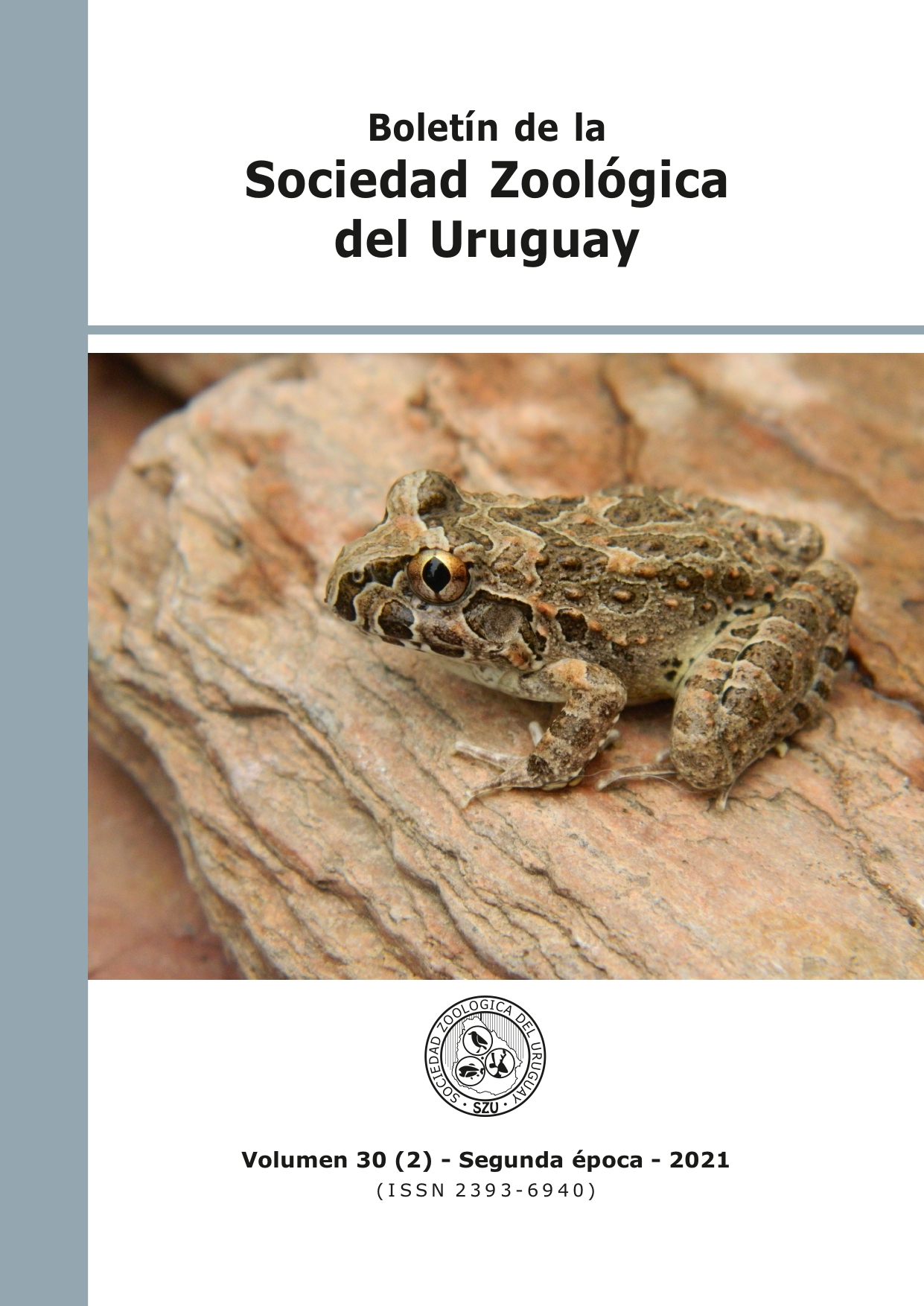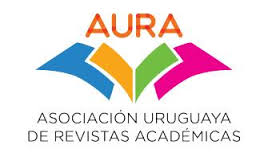ESTRUCTURA FUNCIONAL DE LA MACROFAUNA BENTÓNICA EN SISTEMAS ESTUARINOS URUGUAYOS
DOI:
https://doi.org/10.26462/30.2.4Palavras-chave:
BTA, grupo funcional, macrobentos submareal, escalas espaciales, UruguayResumo
Se estudió la estructura funcional del macrobentos de dos sistemas estuarinos morfológicamente distintos (lagunas costeras y estuarios de desembocaduras de arroyos) con el objetivo de determinar diferencias entre los rasgos funcionales predominantes de ambos sistemas. Se clasificó el macrobentos en grupos y rasgos funcionales a través del análisis de rasgos biológicos (BTA por su sigla en inglés). Dada la dependencia según
la escala del macrobentos, se muestreó en dos ocasiones (otoño y primavera) en tres escalas espaciales: hábitat (estuarios y lagunas), sectores del hábitat (internos y externos) y sitios réplica (tres en cada sector). Dos hipótesis fueron planteadas (1) la geomorfología del cuerpo de agua determinaría los rasgos funcionales presentes y (2) el estado trófico de un ambiente condicionaría los rasgos funcionales presentes. Ambas se cumplieron para la mayoría de los casos. Como resultado se observó que temperaturas mayores y sedimentos más finos condicionaron la presencia de materia orgánica más degradada y con menor valor nutricional en los muestreos de abril, lagunas y sectores internos. Estas características seleccionaron la presencia de macrobentos depositívoro de superficie, epifaunal y oportunistas de primer y segundo orden, reflejo típico de
sitios perturbados por nutrientes. Por el contrario, los muestreos de octubre, estuarios y sectores externos se caracterizaron por organismos filtradores, infaunales y sensibles al enriquecimiento orgánico, típicos de sitios no perturbados.
Downloads
Referências
Aarnio, K., Mattila, J., Törnroos, A. y Bonsdorff, E. (2011). Zoobenthos as an environmental quality element: the ecological significance of sampling design and functional traits. Marine Ecology, 32, 58–71.
Anderson, M.J., Ford, R.B., Feary, D.A. y Honeywill, C. (2004). Quantitative measures of sedimentation in an estuarine system and its relationship with intertidal soft-sediment infauna. Marine Ecology Progress Series, 272, 33–48.
Alves, A.S., Adão, H., Patrício, J., Magalhães Neto, J., Costa, M.J. y Marques, J.C. (2009). Spatial distribution of subtidal meiobenthos along estuarine gradients in two southern European estuaries (Portugal). Journal of the Marine Biological Association of the United Kingdom, 89, 1529–1540.
Amaral, V. (2015). Bomba de carbono microbiana a lo largo del ciclo hidrológico de una laguna costera. Tesis de Maestría PEDECIBA, UdelaR, Montevideo.
Attrill, M. (2002). A testable linear model for diversity trends in estuaries. Journal of Animal Ecology, 71, 262–269.
Attrill, M. y Rundle, S. (2002). Ecotone or ecocline: ecological boundaries in estuaries. Estuarine, Coastal and Shelf Science, 55, 929–936.
Aubriot, L., Conde, D., Bonilla, S., Hein, V. y Britos, A. (2005). Vulnerabilidad de una laguna costera en una Reserva de Biosfera: indicios recientes de eutrofización. Eutrof de Lag y Emba. CYTED XVIIB, Chile. 65–85.
Bady, P., Dolédec, S., Fesl, C., Gayraud, S., Bacchi, M. y Scholl, F. (2005). Use of inver-tebrate traits for the biomonitoring of European large rivers: the effects of sampling effort on genus richness and
functional diversity. Freshwater Biology, 50, 159–173.
Barry, J. y Dayton, P. (1991). Physical heterogeneity and the organization of marine communities. Ecological heterogeneity, 270–320.
Bremner, J., Rogers, S.I. y Frid, C.L.J. (2003). Assessing functional diversity in marine benthic ecosystems: a comparion of approaches. Marine Ecology Progress Series, 254, 11–25.
Bremner, J., Rogers, S.I. y Frid, C.L.J. (2006). Methods for describing ecological functioning of marine benthic assemblages using biological traits analysis (BTA). Ecological Indicators, 6, 609–622.
Borja, A., Franco, J. y Pérez, V. (2000). A marine biotic index to establish the ecological quality of soft bottom benthos within European estuarine and coastal environments. Marine Pollution Bulletin, 40, 1100–1114.
Byers, S.C., Mills, E.L. y Sewart, P.L. (1978). A comparision of methods to determining organic carbon in marine sediments, with suggestion for a standard method. Hydrobiology, 58, 37–43.
Cardinale, B.J., Srivastava, D.S., Duffy, J.E., Wright, J.P., Downing, A.L., Sankaran, M. y Jousseau, C. (2006). Effects of biodiversity on the functioning of trophic groups and ecosystems. Nature, 443, 989–992.
Cao, Y., Bark, A.W. y Williams, W.P. (1996). Measuring the responses of macroinvertebrate communities to water pollution: a comparison of multivariate approaches, biotic and diversity indices. Hydrobiology, 341, 1–19.
Castella, E. y Speight, M.C.D. (1996). Knowledge representation using fuzzy coded variables: an example based on the use of Syrphidae (Insecta: Diptera) in the assessment of riverine wetlands. Ecological Modelling, 85, 13–25.
Chapin, III F. S., Schulze, E.-D. y Mooney, H. A. (1992). Biodiversity and ecosystem processes. TREE, 7, 107–8.
Charvet, S., Statzner, B., Usseglio-Polatera, P. y Dumont, B. (2000). Traits of benthic macroinvertebrates in semi-natural French streams: an initial application to biomonitoring in Europe. Freshwater Biology, 43, 277–296.
Chevenet, F., Doledec, S. y Chessel, D. (1994). A fuzzy coding approach for the analysis of long-term ecological data. Freshwater Biology, 31, 295–309.
Conde, D., Aubriot, L. y Sommaruga, R. (2000). Changes in UV penetration associated with marine intrusions and freshwater discharge in a shallow coastal lagoon of the Southern Atlantic Ocean. Marine Ecology Progress Series, 207, 19–31.
Conde, D. y Rodríguez-Gallego, L. (2002). Problemática ambiental y gestión de las lagunas costeras atlánticas de Uruguay. En: A. Domínguez y R. Prieto (Eds) Perfil Ambiental 2002 (Pp. 149–166). Nordan, Montevideo.
Conde, D., Rodríguez-Gallego, L. y Rodríguez-Graña, L. (2003). Análisis conceptual de las interacciones abióticas y biológicas entre el océano y las lagunas de la costa Atlántica de Uruguay. Informe final FREPLATA. Sección Limnología, Facultad de Ciencias. Udelar.
Covich, A.P., Austen, M.C., Barlocher, F., Chauvet, E., Cardinale, B.J., Biles, C.L., Inchausti, P., Dangles, O., Solan, M., Gessner, M.O., Statzner, B. y Moss, B. (2004). The role of biodiversity in the functioning of freshwater and marine benthic ecosystems. Bioscience, 54, 767–775.
Day, J., Hall, C., Kemp, W. y Yáñez-Arancibia, A. (1989). Estuarine ecology. Wiley, New York.
Dauvin, J.C., Ruellet, T., Desroy, N., Janson, A.L. 2007. The ecology quality status of the Bay of Seine and the Seine estuary: Use of biotic indices. Marine Pollution Bulletin 55: 241–257.
Dauer, D.M., Ranasinghe, J.A. y Weisberg, S.B. (2000). Relationship between benthic community condition, water quality, sediment quality, nutrient loads, and land use patterns in Chesapeake Bay. Estuaries, 23, 80–96.
Defeo, O., Horta, S., Carranza, A., Lercari, D., de Alava, A., Gómez, J., Martínez, G., Lozoya, J.P. y Celentano, E. (2009). Hacia una implementación de áreas marinas protegidas como herramienta para el manejo y conservación de la fauna marina costera. PDTS/C/OP/07/49 - Facultad de Ciencias,
Universidad de la República, DINARA-MGAP, Uruguay, 138p.
Dell'Anno, A., Mei, M.L., y Danovaro, R. (2002). Assessing the trophicstate andeutrophication of coastal marine system: a new approach basedon the biochemicalcomposition of sediment organic matter. MarinePollution Bulletin, 44, 611–622.
Diamond, J. y Case, T.J. (1986). Overview: introductions, extinctions, exterminations and invasions. En: J. Diamond, T.J. Case (Eds). (Pp. 65–79). Comm ecol. Harper y Row, New York.
Drobner, U., Bibby, J., Smith, B. y Wilson, J.B. (1998). The relation between community biomass and evenness: what does community theory predict, and can these predictions be tested? Oikos, 82, 295–302.
Dell' Anno, A., Mei, M.L. y Danovaro, R. (2002). Assessing the trophic state and eutrophication of coastal marine system: a new approach based on the biochemical composition of sediment organic matter. Marine Pollution Bulletin, 44, 611–622.
Echeverría, C., Neves, R., Pessoa, L. y Paiva, P. (2010). Spatial and temporal distribution of the gastropod Heleobia australis in an eutrophic estuarine system suggests a metapopulaton dynramics. Natural Science, 2:8, 860–867.
Elliott, M. y Quintino, V. (2007). Estuarine Quality Paradox, Environmental Homeostasis and the difficulty of detecting anthropogenic stress in naturally stressed areas. Marine Pollution Bulletin, 54, 640–645.
Ellis, J.I., Clark, D., Atalah, J., Jiang, W., Taiapa, C., Patterson, M., Sinner y Hewitt J. (2017). Multiple stressor effects on marine infauna: responses of estuarine taxa and functional traits to sedimentation, nutrient and metal loading. Scientific Reports, 7, 12013 p 1–16.
Folk, R.L. y Ward, W.C. (1957). Brazos River bar: a study of the significance of grain size parameters. Journal of Sedimentary Petrology, 27, 3–26.
Giménez, L. y Yannicelli, B. (2000). Longshore patterns of distribution of macroinfauna on a Uruguayan sandy beach: an analysis at different spatial scales and of their potential causes. Marine Ecology Progress Series, 199, 111–125.
Giménez, L., Borthagaray, A.I., Rodríguez, M., Brazeiro, A. y Dimitriadis, K. (2005). Caledependent patterns of macroinfaunal distribution in soft sediment intertidal habitats along a large-scale estuarine gradient. Helgol. Marine Research, 59, 224–236.
Giménez, L., Dimitriadis, C., Carranza, A., Borthagaray, A.I. y Rodríguez, M. (2006). Unravelling the complex structure of a benthic community: A multiscale-multianalytica approach to an estuarine sandflat. Estuarine Coastal and Shelf Science, 20, 1–11.
Giménez, L., Venturini, N., Kandratavicius, N., Hutton, M., Lanfranconi, A., Rodríguez, M., ... Muniz, P. (2014). Macrofaunal patterns and animalsediment relationships in Uruguayan estuaries and coastal lagoons (Atlantic coast of South America). Journal of Sea Research Doi, 10.1016/j.seares.2013.12.005.
Goodman, D. (1982). Optimal life histories, optimal notation, and the value of reproductive value. The American Naturalist, 119, 803–823.
Gray, J.S. y Elliot, M. (2009). Ecology of Marine Sediment, for Science to Management, second ed. Oxford University Press.
Holland, A.F., Shaughnessy, A.T. y Hiegel, M.H. (1987). Long-term variation in mesohaline Chesapeake Bay macrobenthos: Spatial and temporal patterns. Estuaries, 10, 227–245.
Hooper, D., Chapin, F., Ewel, J., Hector, A., Inchausti, P., Lavorel, S., Lawton, J., Lodge, D., Loreau, M. y Naeem, S. (2005). Effects of biodiversity on ecosystem functioning: a consensus of current knowledge. Ecological Monographs, 75, 3–35.
Incera, M., Cividanes, S., Lastra, M. y López, J. (2003). Temporal variability of sedimentary organic matter in Sandy beaches onthe northwest coast of the Iberian Peninsula. Estuarine Coastal and Shelf Science, 58, 55–61.
Kandratavicius, N. (2011). “Ecología de la comunidad meiobentónica de estuarios uruguayos: una aproximación mediante múltiples escalas”. Tesis Maestría PEDECIBA-Biología, Udelar, Montevideo.
Kandratavicius, N., Muniz, P., Venturini, N. y Giménez, L. (2015). Meiobenthic communities in permanently open estuaries and open/closed coastal lagoons of Uruguay (Atlantic coast of South America). Estuarine Coastal and Shelf Science, 163, 44–53.
Kjerfve, B. (1994). Coastal lagoons process. Else. Ocean. Ser., 60, Elsevier Science Publishers.
Kjerfve, B. y Magill, K. (1989). Geographic and hydrodynamic characteristics of shallow coastal lagoons. Marine Geology, 88, 187–199.
Lavorel, S., McIntyre, S., Landsberg, J. y Forbes, T.D.A. (1997). Plant functional classifications: from general groups to specific groups based on response to disturbance. Trends in Ecologyand Evolution, 12, 474–478.
Levin, L.A., Boesch, D.F., Covich, A., Dahm, C., Erseus, C., Ewel, K.C., ... Weslawski, J.M. (2001). The function of marine critical transition zones and the importance of sediment biodiversity. Ecosystems, 4, 430–451.
Lorenzen, C.J. (1967). Determination of chlorophyll and pheopigments: spectrophotometric equations. Limnology and Oceanograohy, 12, 434–346.
Mouillot, D., Spatharis, S., Reizopoulou, S., Laugier, T., Sabetta, L., Basset, A. y Do Chi, T. (2006). Alternatives to taxonomic-based approaches to assess changes in transitional waters communities. Aquatic Conservation: Marine and Freshwater Ecosystem, 16, 469–482.
Morrisey, D., Howitt, L., Underwood, A. y Stark, J. (1992). Spatial variation in soft-sediment benthos. Marine Ecology Progress Series, 81, 197–204.
Mlambo, M.C. (2014). Not all traits are “functional”: insights from taxonomy and biodiversityecosystem functioning research. Biodiversity and Conservation, 23, 781 – 790. http://dx.doi.org/10.1007/s10531-014-0618-5.
Murphy, G. (1968). Patterns in life history and the environment. The American Naturalist, 102, 391–403.
Muniz, P., Venturini, N. y Burone, L. (2006). Contaminación de la Bahía de Montevideo y zona costera adyacente y su relación con los organismos bentónicos. En: R. Menafra, L. Rodríguez-Gallego, F. Scarabino, Conde (Eds). Bases para la conservación y el manejo de la costa uruguaya (pp. 467–476). Vida Silvestre Uruguay, Montevideo.
Muniz, P., Hutton, M., Kandratavicius, N., Lanfranconi, A., Brugnoli, E., Venturini, N. y Giménez, L. (2012). Performance of biotic indices in naturally stressed estuarine environments on the Southwestern Atlantic coast (Uruguay): A multiple scale approach. Ecological Indicators, 19, 89–97.
Papageorgiou, N., Sigala, K. y Karakassis, I. (2009). Changes of macrofaunal functional composition
at sedimentary habitats in the vicinity of fish farms. Estuarine Coastal and Shelf Science, 83, 561–568.
Pereira, J., Rodríguez, M., Santos, S., Kandratavicius, N., Bueno, C., Rodríguez, M., ... Muniz, P. (2019). Variación en pequeña escala de la estructura horizontal y vertical de comunidades macrobentónicas en una laguna costera del Atlántico Sudoccidental. INNOTEC (Revista del Laboratorio Tecnológico del Uruguay), 18, 88–110.
Piló, D., Ben-Hamadou, R., Pereira, F., Carric, A., Pereira, P., Corzo, A., ... Carvalhoa, S. (2016). How functional traits of estuarine microbenthic assemblages respond to metal contamination? Ecological Indicators, 71, 645–659.
Pita, A. (2012). “Bioquímica de la materia orgánica y estado trófico de los sedimentos en ambientes estuarinos de la costa uruguaya”. Tesina Licenciatura, Facultad de Ciencias, Udelar, Montevideo.
Pita, A., Giménez, L., Kandratavicius, N., Muniz, P. y Venturini, N. (2017). Benthic trophic status of
aquatic transitional environments with distinct morphological and dynamic characteristcs on the south-western Atlantic coast. Marine and Freshwater Research, http://dx.doi.org/10.1071/MF16284
Pearson, T.H. y Rosenberg, R. (1978). Macrobenthic succession in relation to organic enrichment and pollution of the marine environment. Oceanography and Marine Biology Annual Review, 16, 229–311.
Pusceddu, A., Gambi, C., Manini, E. y Danovaro, R. (2007). Trophic state, ecosystem efficiency and biodiversity of transitional aquatic ecosystem: analysis of environmental quality based on different benthic indicators. Chemistry and Ecology, 23 (6),505–515.
Pusceddu, A., Bianchelli, S., Gambi, C. y Danovaro, R. (2011). Assessment of benthic trophic status of marine coastal ecosystems: Significance of meiofaunal rare taxa. Estuarine Coastal and Shelf Science, 93, 420–430.
Sigala, K., Reizopoulou, S., Basset, A. y Nicolaidou, A. (2012). Functional diversity in three Mediterranean transitional water ecosystems, Est., Coast. and Shelf Sci., http://dx.doi.org /10.1016/j.ecss.2012.06.002
Suguio, K. (1973). Introdução à sedimentologia. Edgar Blücher/Editora da Universidade de São Paulo. 312 pp.
Sündback, K. (1983). Microphytobenthos on sand in shallow brackish water. ÖresundSweeden. Primary production, chlorophyll a content and spices composition (Diatom) in relation to some ecological factors. Doctoral Thesis. Department of Systematic Botany, University of Lund, Sweeden. LUNDS/ (NBBS-1006): 209p.
Teske, P. y Wooldridge, T. (2001). A comparison of the macrobenthic faunas of permanently open and temporarily open/closed South African estuaries. Hydrobiologia, 464, 227–243.
Teske, P. y Wooldridge, T. (2003). What limits the distribution of subtidal macrobenthos in permanently open and temporarily open/closed South African estuaries? Salinity vs. sediment particle size. Estuarine Coastaland Shelf Science, 57, 225–238.
Thrush, S., Cumming, V., Dayton, P., Ford, R., Grant, J., Hewitt, J., ... Wilkinson, M. (1997). Matching
the outcome of small-scale density manipulation experiments with larger scale patterns as example of bivalve adult/juvenile interactions. Journal of Experimental Marine Biology and Ecology, 216, 153–169.
Thrush, S., Hewitt, J., Norkko, A., Nicholls, P., Funnell, G. y Ellis, J. (2003). Habitat change in estuaries: predicting broad-scale responses of intertidal macrofauna to sediment mud content. Marine Ecology Progress Series, 263, 101–112.
Tilman, D. (2001). Functional diversity. En: S.A. Levin (Ed.). Encyclopaedia of Biodiversity (pp. 109–120). Academic Press, San Diego, USA.
Usseglio-Polatera, P., Bournard, M., Richoux, P. y Tachet, H. (2000). Biomonitoring through biological traits of benthic macroinvertebrates: how to use species trait databases? Hydrobiol, 422/423, 153–162.
Van der Linden, P., Marchini, A., Dolbeth, M., Patrício, J., Veríssimo, H. y Marquesa, J.C. (2016). The performance of trait-based indices in an estuarine environment. Ecology Indicators, 67, 378–389.
Venturini, N., Muniz, P. y Rodríguez, M. (2004). Macrobenthic subtidal communities in relation to sediment pollution: the phylum-level metaanalysis approach in a south-eastern coastal region of South America. Marine Biology, 144, 119–126.
Venturini, N., Pita, A.L., Brugnoli, E., García-Rodríguez, F., Burone, L., Kandratavicius, N., ... Muniz, P. (2012). Benthic trophic status of sediments in a metropolitan area (Rio de la Plata estuary): Linkages with natural and human pressures. Estuarine, Coastal and Shelf Science, doi.org/10.1016/j.ecss.2011.08.016.
Warwick, R.M. y Somerfield, P.J. (2008). All animals are equal but some are more equal than others. Journal of Experimental Marine Biology and Ecology, 366, 184–186.
Ysebaert, T. y Herman, P. (2002). Spatial and temporal variation in benthic macrofauna and relationships with environmental variables in an estuarine, intertidal soft-sediment environment. Marine Ecology Progress Series, 244, 105–124.











